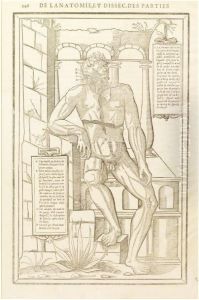Charles Estienne Paintings
Charles Estienne was a notable French Renaissance scholar, physician, and publisher. He was born in 1504 in Paris, France, into a family with a rich intellectual heritage. His father, Henri Estienne, the Elder, was a famous printer, and his brother, Robert Estienne, was also a prominent scholar and printer. Charles was destined to follow in his family's footsteps, contributing to the world of academia and publishing.
Estienne's education was comprehensive and classical, likely involving studies in the humanities, science, and medicine. He pursued a degree in medicine and became a doctor, but his interests extended beyond the medical field into the realms of botany and anatomy. He was particularly fascinated by the natural world and sought to understand and document it.
In his lifetime, Charles Estienne produced several important works. Among them, his most famous contribution to literature and science is 'Praedium Rusticum,' a compendium on agriculture and rural life, which includes a vast array of topics from gardening to veterinary science. He also authored 'De Dissectione Partium Corporis Humani Libri Tres' (Three Books on the Dissection of the Parts of the Human Body), which was a significant work in the field of anatomy. Unfortunately, due to the censorship and the religious tensions of the time, the complete work on anatomy was not published until after his death.
Estienne's work in anatomy, while not as well-known as that of his contemporary Andreas Vesalius, contributed to the growing body of knowledge on human anatomy. His illustrations and text provided insight into the human body at a time when such studies were still emerging from the shadows of ancient traditions and superstitions.
Despite his achievements, Charles Estienne's life was not without its difficulties. He faced financial troubles, possibly exacerbated by his dedication to his scholarly pursuits and the competitive nature of the publishing industry at the time. He died in debtor's prison in Paris in 1564, leaving behind a legacy of knowledge and scholarly work that would influence future generations.
Charles Estienne's contributions to science and literature were part of the broader intellectual movement of the Renaissance, which laid the groundwork for modern science and learning. His works are remembered for their detail and accuracy, and they reflect the spirit of inquiry and the pursuit of knowledge that characterized his era.
